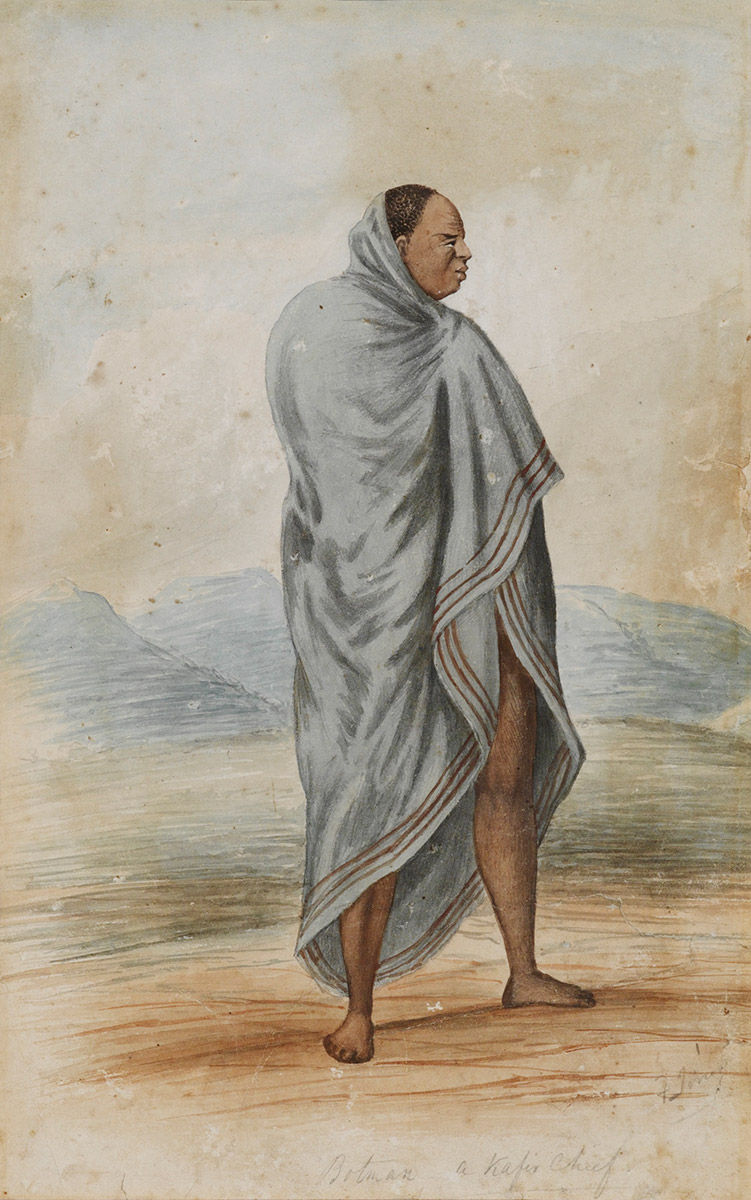Frederick Timpson Botman I’ONS (1802 – 1887)
Chief
year unknown
watercolour on paper
27 x 16.5 cm
I’Ons’s patrons were mostly military types who commissioned portraits, but his real talent was for depicting the people of the area whom he encountered in his everyday life, painted in situ against detailed Eastern Cape landscapes and woodland scenes.
He is best known for his formal portraits of African chiefs, including Maqoma (the most renowned Xhosa chief in South Africa’s frontier wars), Sandile (whose territory was put under British command following his defeat during the Seventh Frontier War of 1846–47) and Khama (Chief of the Bamangwato, who converted to Christianity in 1860 and acquiesced to the British when Bechuanaland was declared a protectorate in 1885). This portrait of a local chief is one of these depictions. The black and white striped ingcawa blanket in which the chief is enveloped is a distinctive feature of Xhosa traditional dress.
SOURCES
http://www.sahistory.org.za/people/chief-maqoma
http://www.sahistory.org.za/dated-event/xhosa-chief-sandile-killed
http://www.britannica.com/EBchecked/topic/316197/Khama-III
BIOGRAPHY
Frederick Timpson Botman I’Ons was born in Islington, Middlesex (now a borough of Greater London) and showed an early talent for drawing. Except for lessons with the sculptor John Francis, I’Ons had no formal training in art. Nonetheless, as a young man, he ran an art school in Marylebone, where he taught drawing, painting and commercial subjects.
It was the ill health of his wife, Ann Frazer, that inspired the couple’s migration to Grahamstown (now Makhanda) in the Eastern Cape in 1834. They arrived at the start of the Sixth Frontier War, in which he participated. It was during this time that he produced his Aquila Caricatures, a series of satirical pieces directed at Andries Stockenström, the lieutenant governor of what was then British Kaffraria.
He eked out his income by painting stage decor, portraits of notable Grahamstown residents and giving art classes. A trip to the diamond diggings at Kimberley did not improve his fortunes. His works provide an important insight into frontier life in the 1800s, and have been exhibited by Tate Gallery in London (1948), the South African National Gallery in Cape Town (1976), and King George VI Gallery in Port Elizabeth (1990). His paintings may be found in private and public collections, including the Africana Museum, Albany Museum, King George VI Art Gallery, Iziko South African National Gallery and the University of Stellenbosch.


